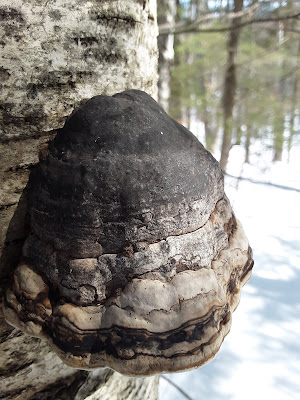Finding Mushrooms of the Iceman
"While most of my job includes caring for dead things, I am occasionally allowed to interact with live humans." Most participants chuckled as I introduced myself in the front of the classroom, flanked by a gray wolf mount and a display of pinned insects. While it's true that much of my work involves the curation of museum specimens, the nature of my particular position also grants me the opportunity to take others outdoors to share my interests. On that particular winter day, I would be introducing others to the mushrooms of the Iceman.
 |
| A mature fruiting body of Fomes fomentarius (sometimes called Tinder Polypore) exposed on its typical host, native Paper Birch. |
The group had gathered on a warm, breezy morning to seek out two species of bracket fungi that grow in our area--often referred to as tinder polypore (Fomes fomentarius) and birch polypore (Fomitopsis betulina). I had originally conceived of the program topic after watching yet another documentary about Ötzi the Iceman, a famous 5,300 year old glacier mummy discovered in the Ötztal Alps of Europe during the early 1990's. His remains were found with a variety of possessions, including pieces of birch polypore tied to leather and remnants of tinder polypore in what was likely a fire-starting kit. Impeccably preserved, both the iceman and his equipment provided important insights into prehistoric survival.
Both species of fungi act as parasites to certain deciduous trees which generally grow in mixed temperate to boreal forests around the world. So, such fungi can be found in the forests that I often roam, and have become distinctly familiar to me since my initial fascination with fungi. They decompose wood, thus when found, their host is undoubtedly at some stage of death. Nonetheless I enjoy discovering their fruiting bodies and utilizing them for my own benefit at times when I find it necessary and nondestructive to harvest.
 |
| During autumn, I often run into the live fruiting bodies of Fomitopsis betulina (Birch Polypore) and harvest some to dry and use in a medicinal tea. |
The group of people who joined me that morning of the program were interested in discovering the same. We made our way to a nearby forest and fastened on snowshoes to travel through the deep snow cover. After a short distance through tall pines, a stand of white birch became exposed. All the dead or dying trunks of these typical polypore hosts were covered in multiple bracket fungi, including tinder polypore. The common name is indicative of its most well-known use--as material for starting a fire. We found a dry growth and attempted to verify this ourselves--we were eventually successful but could probably use more practice. Creating a fire isn't the only value to that has been recognized for thousands of years, though. Tinder polypores also have use as substitute material for leather, a drying material for fishing flies, and even as medicine for humans and bees!
After some fire-starting fun, we continued our morning in another area to find some birch polypores. Unlike tinder polypore, the birch polypore is an annual--the fruiting body grows any time between spring and fall and dies roughly a year later. We didn't discover any live specimens that day, but did see some that had already died. Dead, the birch polypore would really only be valuable to us as tinder that produces smoke which apparently repels insects. When harvested live, the species has value as medicine, material for knife strops, and as a back-country bandage.
After an enjoyable morning outdoors, I led the group back into the building. We enjoyed some birch polypore tea, which I had prepared from previously harvested and dried fungi, and then went our separate ways. It was a break from the usual routine for everyone, I'm sure, and I myself was happy for the experience. On most days I try to build meaningful connections between visitors and the natural environment through our many specimens. While that route brings me joy as well, I can't pretend to not occasionally prefer a forest hike with others to a room filled with taxidermy work.

